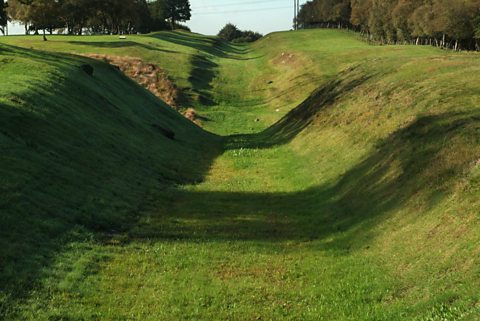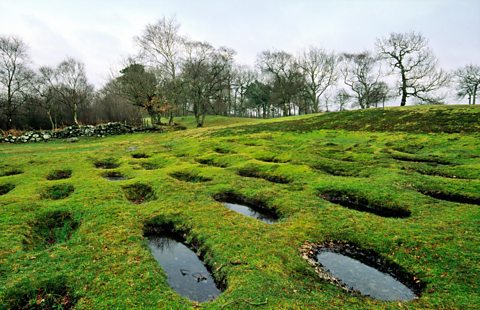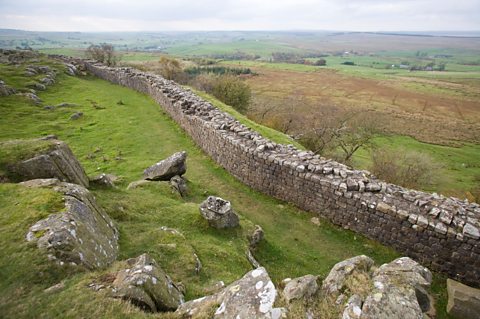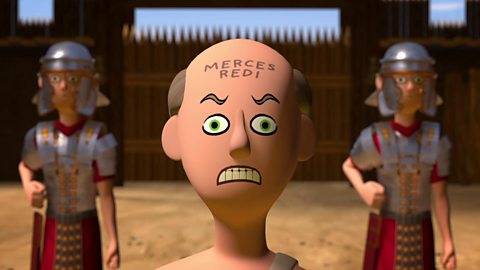What was the Antonine Wall?
The Antonine Wall was built by the Romans between the Firth of Clyde and Firth of Forth. Building started in 143AD and took around ten years to complete. But what was the wall like and why was it there?
Find out why the Romans built an enormous wall that spanned the width of Scotland.
ANITA: The Romans in Scotland, The Antonine Wall. Romes second invasion.
Hello, my name’s Anita, my mum's a history professor and my dad’s an civil engineer, he gets very excited by walls so, sorry about that. I’ve got a project for school about the Romans and I bet I know why I’m here. Is this Roman?
MUM: Yes! We’re in Bearsden, north of Glasgow and here are remains of a Roman fort, built on the Antonine Wall.
ANITA: Wall? What, that wall?
DAD: Yes, and the Romans lived in those flats! Very handy for the shops.
MUM: No no. None of this was here. Imagine, this used to be a fort, one of many that spanned a great Roman wall.
ANITA: Wait, did the Romans conquer Scotland then?
MUM: The Romans had invaded in 79 AD under their leader, Agricola. But after 10 to 20 years they had retreated to a line between the Solway Firth and the River Tyne. 40 years later, tribes in what is now the north of England and Scottish borders, rebelled.
The Emperor Hadrian himself came to Britain, and in 122 AD, ordered that a wall be built.
ANITA: Hadrian's Wall!
MUM: Yes!
ANITA: Can we go?
MUM: But your project is Romans in Scotland.
ANITA: Yes?
MUM: None of Hadrian's Wall is in Scotland.
ANITA: Oh.
MUM: But Hadrian had a son, Emperor Antonius Pius, who ordered the Roman governor of Britain, Urbicus, to push the border north.
In 139 AD, Urbicus, at the head of three legions, that’s 15,000 soldiers, marched into what is now Scotland.
They pushed north but stopped at the narrowest point they could defend, between the rivers Clyde and Forth. And then they started building.
Starting in 143 AD the Antonine Wall took maybe ten years to build!
ANITA: Ten years?!
DAD: Its wasn’t just a simple garden wall, it was huge! And they built it with hand tools! With a stone base and turf sides with a wooden fence on top!
And it wasn’t just a wall, there were towers! Watch Towers, so soldiers could keep an eye out for any problem coming. And 25 forts joined by a road called a Military way. And there was a ditch in front of the wall and picks, with sharp spikes on them.
ANITA: Spikes?!
MUM: Yes. Imagine …
Soldiers on top, spikes below. You wouldn’t dare attack!
ANITA: So, the Romans lived here then?
MUM: Yes thousands of Romans soldiers stayed at the new border of the Empire.
DAD: Shaping the future of Scotland by fighting, mixing and trading with the local people.
MUM: But eventually, the soldiers that guarded it were needed elsewhere, to defend parts of the Empire closer to Rome. So the Antonine Wall was abandoned.
ANITA: I think I’m needed elsewhere…
Sweetie shop!
Why did the Romans build walls?

For the Romans, high walls served more than one function.
The most important functions was defence – high walls make it easier to protect an area from attack.
By the time walls such as Hadrian’s Wall or the later Antonine Wall were built, there had been lots of serious rebellions and attacks by the British tribes. Walls were one solution.
As well as providing a physical barrier that attackers had to either over or through, high walls also meant that only small numbers of Roman soldiers were required to defend large areas,
Walls also had other uses. The Romans also used walls to control trade between areas. If merchants wanted to enter into a territory to trade they would first have to pay a tax.

Why was the Antonine Wall built?

The Antonine Wall was thirty-seven miles long and ran east to west from the Firth of Forth to the Firth of Clyde. Its name comes from the Roman Emperor who ordered it to be built – Antoninus Pius.
Although the Romans had made previously fought their way further north in Scotland, the Antonine Wall was the boundary of all the land they controlled.
The Romans began building the Antonine Wall in 142 AD. At the time it was finished, it marked the northern edge of the Roman Empire.
Beyond it, the rest of northern Scotland was under the control of the Caledonian tribes.
The wall was made from heaping up enormous piles of earth and turf and had deep ditches to make it easier to defend. Sixteen Roman forts were built along the length of the wall to help protect it.
It took around ten to twelve years to build the wall but, after only eight years of defending it, the Romans pulled back from the wall and retreated to northern England behind the safety of another wall they’d built twenty years earlier – Hadrian’s Wall.

Why was the Antonine Wall abandoned?

It had been an aim of the Roman Emperor, Antoninus Pius, to defeat the Caledonian tribes and push Roman control deeper into norther Scotland. After Pius died in 161 AD this goal was largely abandoned by the new Emperor, Marcus Aurelius.
It seems likely that the Antonine Wall became to expensive to defend and so it was abandoned. At the time this happened Rome had lots of other problems.
The tribes in northern England and southern Scotland were rebelling against Roman rule and, elsewhere in Europe, Rome was fighting costly wars. The troops required to defend the Antonine Wall were needed elsewhere.
The Roman forces in Scotland retreated behind the larger, stone-built Hadrian’s Wall and, over time, the Antonine Wall became ruins.Despite this, parts of it can still be seen today in places such as Bearsden, north of Glasgow.

More on Romans
Find out more by working through a topic
- count5 of 9

- count6 of 9

- count7 of 9

- count8 of 9
